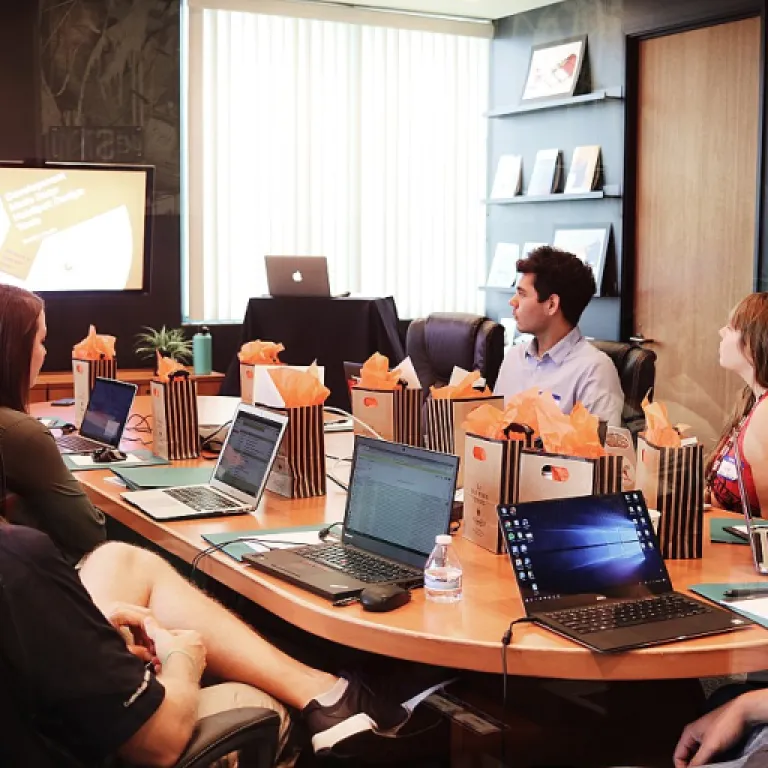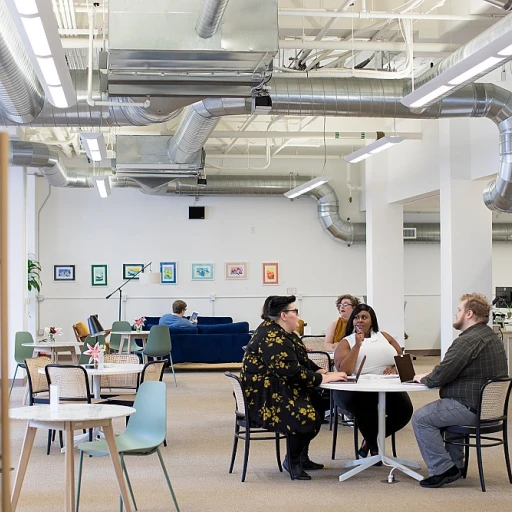
Understanding the Future of Work
The Evolving Landscape of Work
The future of work is a dynamic and ever-evolving landscape that organizations must navigate with strategic foresight. As we move forward, the traditional notions of work are being reshaped by technological advancements, shifting employee expectations, and the rise of remote work. These changes are not just superficial; they are fundamentally altering how organizations operate and how employees engage with their work.
Adapting to New Realities
Organizations are increasingly recognizing the need to adapt their human resource management strategies to keep pace with these changes. Leaders and managers are tasked with fostering an environment where employees feel valued and engaged, which is crucial for maintaining high levels of organizational effectiveness. This involves not only understanding the needs of employees but also implementing practices that support employee development and improve employee experience.
Embracing Flexibility and Technology
Flexibility is becoming a cornerstone of the modern workplace. Remote work and hybrid models are gaining traction, offering employees the autonomy to balance their professional and personal lives. This shift requires organizations to leverage technology effectively to maintain communication and collaboration among teams. By doing so, they can ensure that employees remain engaged and productive, even when working from different locations.
Fostering a Culture of Engagement
Creating a culture where employees are actively engaged is more important than ever. Engaged employees are more likely to contribute to high performance and drive organizational success. To achieve this, organizations must focus on strategic HR practices that prioritize employee engagement. This includes providing the right tools and resources, fostering open communication, and ensuring that employees feel supported by their leaders and managers.
For more insights on enhancing employee engagement, consider exploring the role of a workplace experience manager in driving organizational success.
The Role of Human Resource Management
Human Resource Management: A Catalyst for Engagement
In today's evolving workplace, human resource management stands as a pivotal pillar for enhancing engagement among employees. Effective HR practices can substantially elevate the employee experience, yielding high performance and fostering a thriving organizational environment. The essence of employee engagement lies in making employees feel valued and involved in the organization’s mission. Human resource strategies can achieve this by focusing on communication and development initiatives. By implementing tools and practices that encourage open communication, organizations can ensure that managers and employees maintain a clear, mutual understanding. This builds a culture where employees feel heard and appreciated, which is essential for maintaining high levels of engagement. Similarly, investing in professional development opportunities allows employees to grow within their roles. When employees see a tangible path to advancement, their motivation and engagement levels often increase. This investment not only benefits individuals but also enhances overall organizational effectiveness by nurturing talent from within. Human resource leaders play a critical role in aligning organizational goals with employee aspirations. By acting as a bridge between management and employees, HR managers can tailor strategies to support employee engagement. This alignment drives the performance needed to achieve organizational milestones. While the challenges of remote work and diverse workforces present new hurdles, thoughtful resource management approaches can shape an inclusive environment where employees remain highly engaged. Strategic HR practices are crucial for creating such adaptive frameworks that encourage engagement and improve employee satisfaction. For further insights on how communication can be optimized to boost engagement in modern workplaces, explore the role of an internal communications agency. This can be an invaluable resource in clarifying goals and fostering a cohesive company culture that keeps employees motivated and actively engaged.Strategies for Employee Engagement
Boosting Engagement Through Specific Initiatives
Effective employee engagement requires a strategic approach where human resource leaders prioritize creating an environment where employees feel valued, motivated, and integrated into the organizational goals. It’s not just about policies but about nurturing an organizational culture driven by mutual respect and open communication. To achieve high levels of engagement, leaders and managers need to adopt specific strategies that align with the evolving landscape of work.
First, it's crucial to foster a culture of open communication. Employees should feel comfortable voicing their concerns and suggestions, leading to a vibrant exchange of ideas that enhances employee experience. Regular meetings, feedback sessions, and the use of digital tools can facilitate seamless information flow within organizations.
Next, focus on personal development. Offering opportunities for growth and learning not only improves skills but also increases organizational effectiveness. Employees who see a clear path for progression are more likely to remain engaged and perform at high levels. Whether through mentorship programs, training workshops, or encouraging lateral moves, giving employees room to grow can significantly enhance their engagement levels.
Recognition and rewards also play a vital role in making employees feel appreciated and motivated. Tailored reward systems that recognize both hard work and innovative thinking not only make employees feel valued but also cultivate a sense of ownership within the organization.
Fostering a Supportive Environment
Organizations must also invest in creating a supportive environment that takes into account the diverse needs of their workforce. From the dynamics of remote work to the challenges posed by multi-generational teams, today’s workforce requires flexible support systems. This includes adopting flexible work arrangements that cater to an employee's life commitments, thereby improving work-life balance and reducing the risk of employees becoming actively disengaged.
Implementing these strategies requires involvement from both leaders and managers. They are pivotal in setting the tone for engagement and organizational culture. By leading by example and supporting their teams, they can transform organizational strategies into practical, daily habits that reinforce a positive and inclusive workplace.
Continual assessment and adaptation of these strategies are essential. Times are always changing, and what worked yesterday might not be as effective tomorrow. Utilizing employee feedback and organizational metrics will help in fine-tuning strategies to ensure they remain effective in improving employee engagement.
For more insights into effective implementation and to see how others have boosted their engagement strategies, consider exploring fully integrated strategies that align with future workplace needs.
Leveraging Technology for Engagement
Integrating Advanced Technologies to Enhance Involvement
In today's dynamic work environments, leveraging technology has become a cornerstone to elevate employee engagement. With a shift towards more sophisticated digital tools, organizations are presented with opportunities to enhance how they connect and engage with their workforce. To improve employee experience, the strategic integration of technology into human resources operations is essential. Once implemented effectively, these digital solutions not only foster better communication but also boost performance through various means:- Streamlining Communication: Modern communication platforms ensure that employees are informed, connected, and involved in organizational developments, making them feel valued within the organization.
- Enhancing Performance Tracking: Technologies that facilitate performance management enable managers to maintain high levels of engagement. Feedback and progress are communicated more effectively, assisting employees in professional development.
- Facilitating Remote Work: As remote work garners momentum, technology becomes a crucial enabler for maintaining engagement levels. This is achieved by supporting seamless collaboration among remote teams, ensuring they remain connected and engaged with their work.
- Fostering Employee Experience: Tools that provide insights into employee satisfaction and well-being can help organizations tailor solutions to meet their needs, thus enhancing overall engagement.
Challenges in Sustaining Engagement
Addressing Barriers to Sustained Engagement
Sustaining high levels of employee engagement can be a significant challenge for organizations. While actively disengaged employees can pose a threat to organizational effectiveness, the journey toward maintaining a team of highly engaged individuals requires continuous effort and strategic foresight. One common hurdle is communication breakdown. To overcome this, leaders and managers must ensure open and transparent communication channels that encourage employees to express their feelings and provide feedback. When employees feel heard and understood, their engagement naturally improves. Another challenge lies in providing meaningful development opportunities. Human resource management must focus on personalized growth paths that align with individual and organizational goals. Employees who see a clear development trajectory are likely to be more committed to their roles. The shift towards remote work has introduced new complexities in maintaining engagement. Managers must use digital tools effectively to foster connection and support employee experiences, ensuring that remote employees feel as engaged as their in-office counterparts. Additionally, addressing the issue of overburdened employees is crucial. Leaders need to monitor workloads and provide management support to prevent burnout, which can significantly hinder engagement. Finally, achieving sustainability in employee engagement requires regular assessment. Organizations should integrate reliable metrics and feedback mechanisms to evaluate how strategies are performing and make data-driven adjustments to continue improving employee engagement. By recognizing these challenges and implementing thoughtful strategies, organizations can strive for a workforce characterized by high performance and strong engagement.Measuring and Improving Engagement
Evaluating Engagement Levels
To effectively measure employee engagement, organizations must first establish clear metrics. These metrics should align with the organization's goals and reflect the desired outcomes of engagement initiatives. Common indicators include employee satisfaction surveys, turnover rates, and productivity levels. By regularly assessing these metrics, leaders and managers can gain insights into how engaged their employees feel and identify areas for improvement.
Tools and Techniques for Measurement
Organizations can leverage a variety of tools to measure engagement. Surveys remain a popular choice, providing quantitative data on employee sentiment. However, qualitative methods such as focus groups and one-on-one interviews can offer deeper insights into the employee experience. Additionally, technology plays a crucial role in gathering real-time feedback through platforms that support employee engagement and communication.
Improving Engagement Through Feedback
Once data is collected, it's essential for management to act on the findings. This involves not only addressing areas of concern but also reinforcing positive aspects of the employee experience. By fostering open communication, leaders can ensure that employees feel heard and valued. This approach not only improves employee engagement but also enhances organizational effectiveness.
Challenges in Measurement and Improvement
Despite the availability of tools and strategies, measuring and improving engagement is not without its challenges. Remote work, for instance, can complicate the assessment of engagement levels. Additionally, actively disengaged employees may skew results, making it difficult to obtain an accurate picture. Organizations must remain vigilant and adaptable, continuously refining their strategies to maintain high levels of engagement.
Continuous Development and Support
Ultimately, the goal is to create an environment where employees are highly engaged and motivated to contribute to the organization's success. This requires ongoing support from leaders and managers, as well as a commitment to human resource development. By prioritizing engagement, organizations can achieve high performance and foster a culture of continuous improvement.












